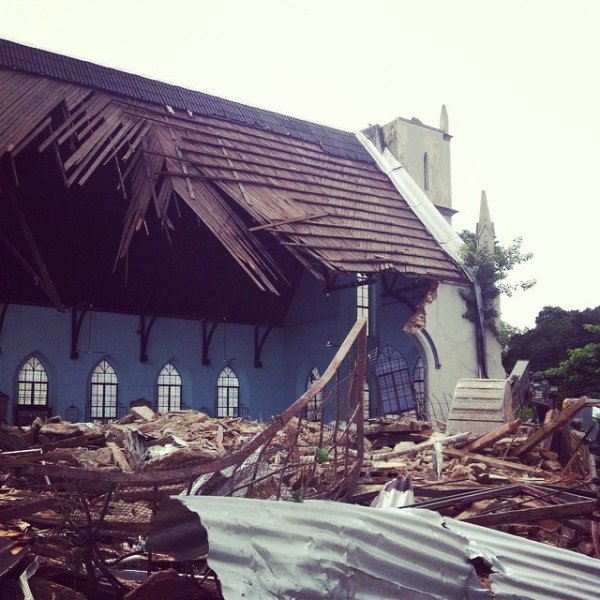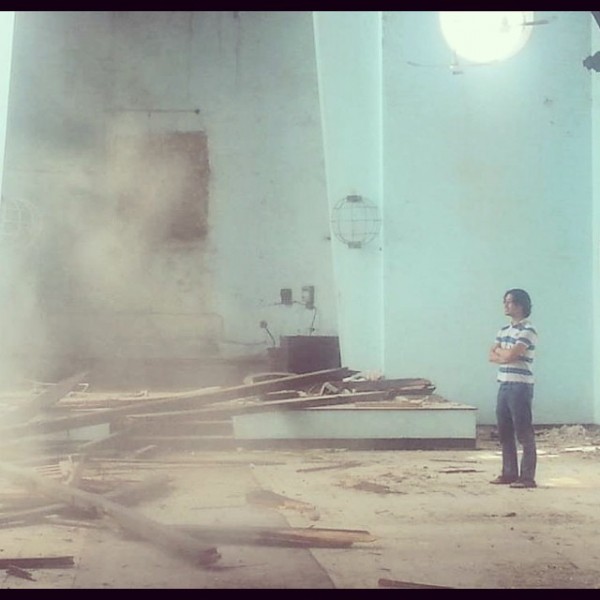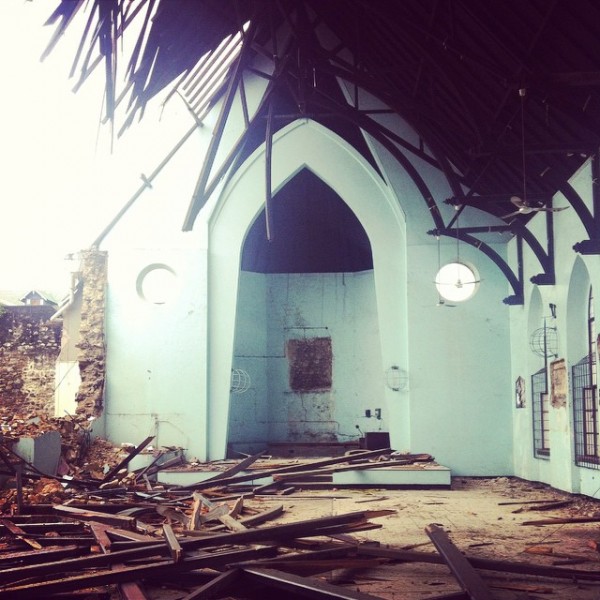
A demolished portion of the historic Greyfriars Presbyterian Church in Port of Spain, Trinidad. The church was built in the 1800s. Photo by Joshua Lue Chee Kong, used with permission.
A centuries-old Presbyterian church in Trinidad and Tobago's capital city was partially bulldozed last Sunday, despite the new owner of the property being in talks with the organisation Citizens for Conservation to devise a plan allowing development at the site while still preserving the historic building.
Demolition on Greyfriars began during the wee hours the morning. Once Rodger Samuel, the minister of of social integration, was alerted, his presence on site halted further destruction of the building. Samuel confirmed that the government, through bodies such as the City Corporation and Town and Country Planning, was in the process of having the building listed as a heritage site, a classification which would have given it legal protection with regard to preservation. But such legal manoeuvres have only come after the sale of the property was announced three months ago.
From as far back as 2007, the church was crying out for assistance. The building needed extensive restoration work, which was well beyond the financial means of Greyfriars dwindling congregation. Nevertheless, repairs began in 2009, and in 2010 the church began soliciting contributions from the wider community. Clearly, these were not sufficient, hence the eventual decision to sell to a private developer.
But this has not quelled the public outrage over new owner Alfred Galy's plan to erect offices where the church once stood. Activist Joshua Lue Chee Kong, who actually stood inside the church while it was being demolished, created an online petition addressed to Galy, Citizens for Conservation and various arms of the government to preserve the church “at any cost”. The petition attracted over 1,200 signatories, stating:
As of today, there is too much ambiguity about the future plans for the structure from the owner, who has already removed most of the roof from the Manse and much of the roof from the church itself, before a stop order was issued by the City Engineer to prevent the removal of any more building materials. Currently Citizens for Conservation of Trinidad and Tobago has provided a proposal to the Minister of National Diversity and Social Integration, the Honourable Rodger Samuel, for the church to be listed as an official National Heritage site. This is very crucial and the matter must to be expedited as the interior of both structures are now exposed to the elements.

Activist Joshua Lue Chee Kong stares down an excavator as it razes part of Greyfriars church in Port of Spain. Photo courtesy Joshua Lue Chee Kong, used with permission.
Similar change of use developments have taken place all around Port of Spain, with historic buildings being given a second life as restaurants, and office buildings, while preserving the integrity of the colonial architecture. On Facebook, where the majority of online discussion about the issue has been taking place, Galy's surreptitious move to bulldoze the property before talks were completed did not sit well with netizens, especially since he had been served with a notice of intention to list Greyfriars as a historic site.
On the Citizens for Conservation Facebook page, Rhona Baptiste felt that the fate of the church was a commentary on where Trinidad and Tobago was as a society:
[…] this is sorry news. But it happens only because we allowed it to happen by not putting in place an IDEOLOGY of LOVE OF SELF AND COUNTRY that now find us in this state of cluelessness.
Kathryn Chan agreed:
terribly sad… no understanding of culture and history… no joy and awe for the hand made building and the sweat and tears of our ancestors… who are we? what are we? where are we going?
There were some commenters who felt that the whole affair was tantamount to much ado about nothing. Denith McNicholls said:
We can't save every old building. I have not been told of the historic significance of the building, other than its age.
Danielle Fran offered a solution:
maybe we should make a list of highest priority for conservation, and then split them up into small manageable groups and distributing responsibility of caretaking/advocating its conservation to one or two persons per group.
Geoffrey MacLean, an architect who is an active part of Citizens for Conservation, responded, saying that in 14 years the National Trust has listed only 13 buildings. Citizens for Conservation are apparently in the process of immediately preparing dossiers for 16 more, with a view to listing another 50 historic buildings out of a list of approximately 400.
The National Trust is charged with the responsibility of identifying and listing historic buildings for legal protection and is supposed to have access to funding, which it can put towards the upkeep of these listed properties. The process involves the submission of a dossier that goes to the relevant line minister which, once approved, goes to Cabinet for consideration in parliament, based on a list of qualification criteria.
In practice, however, the process is not always so smooth. Journalist Francesca Hawkins cut to the heart of the matter when she referred to the demolition as a “failure of policy”. Writer Sharon Millar made the point that “if people understood the listing process and where the kinks in the system lie, the average person might know how and where to place civic pressure.”
The strongest criteria in support of saving Greyfriars as a historic building is, first of all, its social contribution — the church played an active role as a safe haven for religious freedom. It was a sanctuary for Portuguese Presbyterian immigrants who fled from Catholic religious persecution in Madeira and arrived in Trinidad in the 1840s. It was also a key aspect of the landscape vista of Woodford Square, an area of Port of Spain that has been designated as a heritage district. Finally, its architectural significance — the church is designed in the Gothic Revival style — makes it worthy of preservation.
There has also been heated controversy over the demolition based on the fact that the site is hallowed ground, which houses a cemetery. Questions abound as to what this new development means for the integrity of the human remains buried there. Rodney Bridgelal did not mince matters:
I also blame the clergy of that church. Shame on them to leave those bodies there to be desecrated when they knew that their decendants [sic] are still alive.
On December 1, various representatives of the organisations involved in trying to preserve the property, including key government ministries, Citizens for Conservation, the city's mayor and representatives from Town and Country Planning, met with Galy to assess the situation and determine a way forward. President of Citizens for Conservation, architect Rudylynn DeFour-Roberts, who is also a member of the National Heritage Trust Council, said that the meeting was “positive”.
The engineers’ report determined that the structure can be fixed despite its partial demolition, so the building is still worth saving. “We're back in negotiations and discussing options,” she said, emphasising the fact that Greyfriars, as the only historical building on the eastern side of the listed district of Woodford Square, is an important national treasure to be preserved.








2 comments
Shame on you. This is a crime against culture and community. Something Visigoths and Vandals would do.